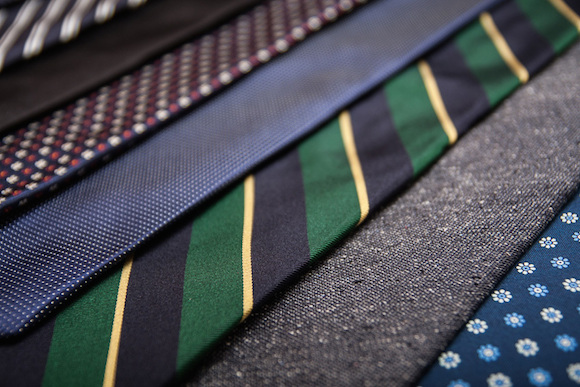
It’s tie-buying season, but there’s more to a good tie than nice looking fabric. Aside from color and pattern do you know what to look for to make sure you’re going to buy and give quality neckwear this holiday season?
DOWNTOWN got tips from ManuelRacim, Tribeca-based custom shirts and tie maker, on the top five things that the discerning shopper should keep their eyes open for when shopping for ties….
Shoddy Fabric
“With few exceptions, you’ll want to avoid pretty much anything that isn’t pure silk or wool,” says Racim. “Besides looking more luxurious, high quality silk or wool will better handle the wear and tear of being knotted tightly, day in, day out, and will outlast several synthetic blend ties. It also drapes more naturally, forming a better hanging knot.”
Machine Stitching
Many of the ties in your wardrobe will have some machine stitching and it isn’t a big deal, but there are places where it’s best to be only hand stitched. A handsewn slipstitch running along the backside of the blade is one of those places.
“A handmade seam has more give than one done by a machine,” explains Racim. “First, it makes a tie less likely to rip under the stress of a taut knot, and second, it allows enough ease of movement that a tie will relax into its original shape when hung.”

Synthetic lining
Most ties are made from a fabric folded three times, then lined with a different material. Some traditional makers do a tie without interlining, from very thin silk folded up to seven times to give the same heft and drape. While delicate, the more complex design signals quality construction. But many factories are now mass-producing poorly made 7-fold ties.
“A good option is a 3-fold style with pure wool interlining. The simple folding pattern allows substantial fabrics to be used, and a natural wool lining shakes wrinkles and retains its form better than any synthetic.”

Garish proportions
You’ve probably heard about how outdated fat ties are, but you should keep an eye out for extreme proportions on either end of the spectrum. Generally, a tie should be no narrower than 2.5″ and no wider than 3.5″. Anything outside of that range is too subject to passing trends. “A tie of about 3″ has looked respectable for the last century, and is probably a safe bet for the next hundred years,” says Racim.
Cheap Details
Check the tie’s keeper and tipping. The keeper is the loop on the back of the tie, used for holding the narrower end in place. Tipping is the material used to finish the exposed back of the tie and hold the interlining in place. Both should be done in the same fabric used to make the rest of the tie. Cheaper manufacturers often use the same generic or synthetic fabric for all of their ties to cut costs.
“Nice details on a tie aren’t a surefire signal of quality, but chances are if the details are off then corners are probably being cut in bigger areas, too. Also, check that above the tipped area, a sturdy horizontal bartack keeps the back of the tie sealed. Cheaper ties will be missing this detail, and are likely to unravel over time.”













